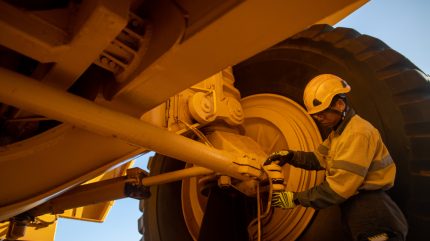
Lubrication is an important component of the mining industry, directly affecting both safety and maintenance activities. The correct use and application of lubricants and coolants helps reduce the likelihood of equipment failures, which can lead to dangerous situations for workers while also helping cut costs* by reducing downtime and machinery part replacement.
One of the primary challenges in mining is maintaining equipment reliability under harsh conditions. Mining equipment is often subjected to extremes – temperature, dust and moisture – which can degrade lubricants and lead to increased wear and tear on machinery. Implementing rigorous lubrication protocols can help improve equipment lifespan and operational efficiency, leading to a more productive and efficient mining environment.
The 10 phases of lubrication
Mobil has been creating and providing the mining industry with expertise and innovative products for over 100 years. Available products and services include MobilSM Lubricant Analysis, startup and compatibility services, inspection services – including gear, bearing, engine, coupling and thermography – and root cause failure analysis. Here, Mobil shares its insider’s guide to the ten key phases for mining lubricants and applications.
1 Fewest correct lubricants
When completing your plant and equipment audit for lubrication products and services, you should be balancing the equipment manufacturers recommendations with the nuances of your plant requirements and local conditions. Look to use the fewest lubricants consistent with sound lubrication practices. This minimises the chance of confusion and error, while also simplifying your inventories, and saving costs* through purchase of the most economic package sizes. Examples of savings possibilities include:
- Fewer products generally require less storage space. For example, one pallet of oil requires about 1.2m² of floor space.
- Each eliminated grease saves a dedicated grease gun and limits cross-contamination of different greases. The cost of loader pumps can easily be identified.
- Eliminating niche products can permit unit-price economies, reduce purchase orders and save accounting and administrative costs.
- Fewer lubricants can improve inventory control and reduce working capital.
- Bulk purchase of large volume products could lower unit costs.
- In some cases, higher-performance greases can be recommended, reducing application frequency and lubricant consumption.
2 Lubrication instructions
Maintenance personnel should follow simple and well-organised instructions to establish efficient equipment lubrication. Available lubrication charts can identify equipment and parts to be lubricated while specifying the correct lubricant, method and frequency of application. It is worth carrying out a routing study or analysis (which determines the optimal path – or route – from one location to another) for maintenance staff. This can sometimes reveal inefficient practices which are leading to high application costs*.
3 Lubrication organisation
Often, on-site plant lubrication is overseen by more than one person and is sometimes split between different departments. You should have in place a comprehensive method of communication (such as a flow chart) showing the differing lines of communication. For example, who informs maintenance what to do, who assigns the work, who carries out the work, who supervises, and who keeps records? Duties and responsibilities of all maintenance personnel should be clear.
In some situations, machine operators have traditionally applied their own lubricants. However, this practice can cause production loss and excessive costs due to additional parts or extra work. Training supervisor and maintenance staff on good lubrication practice will not only provide them with better knowledge of the importance of lubrication on maintenance, plant operations and economics, but also ensure proper application while also reducing labour costs.
4 Lubricating devices
Automatic and semi-automatic lubricating devices can pay for themselves in a relatively short time by reducing labour costs, errors and waste. These devices provide effective lubrication to minimise wear that leads to maintenance downtime and lost production. Typical examples are centralised systems, mechanical force-feed lubricators, automatic spray equipment and power-driven grease guns.
Automation can also save on labour costs, as one person with a hand-operated grease gun can only service a limited number of grease points per shift. However, using grease cartridges can help boost efficiency where there is long travel time to and from application points. Grease cartridges are also cleaner and help avoid grease contamination that can damage bearings. Finally, automated devices can help reduce safety hazards and minimise labour when applying to normally hard to reach lubrication points.
5 Storage and handling
Improving your lubricant handling, storing and dispensing, can be a boon to reducing waste and confusion, minimising fire and safety hazards, and potentially reducing labour, storage and warehousing costs. By analysing how packages are handled, from receipt to storage, you may identify possible cost savings*. For instance, improper storage may cause lubricant contamination and potentially serious damage to equipment.
Damage to drums and labels can lead to confusion about which product to select from the store, potentially resulting in incorrect product application. The cost of handling large-volume requirements can be reduced by installing bulk storage connected to machines or plant stations. Added advantages may be that your insurance rates may be reduced through safer storage methods, while properly designed lubrication trolleys may reduce the number of trips to and from the oil storeroom.
6 Lubricant life
Proper hydraulic and circulation system inspection techniques can help identify contamination and assist in setting up filtering and draining schedules, which can help save labour costs, prolong oil life and minimise shutdowns for oil changes. Further analysis of leakage from circulation systems can also help reveal how to save oil and secure the long life of high-quality oils. For instance, one drop of leaking oil per second can add up to over 1,000 litres per year if left unattended[i].
A simple visual inspection of oil in reservoirs can often show contamination and changes in oil viscosity and general oil condition. When visual inspection suggests the possibility of more serious issues, a more in-depth, lab analysis of in-service lubricants will evaluate oil condition. This service is particularly useful in determining the change interval in large systems.
A cost-benefit study could indicate how a laboratory service could provide your particular site with savings* as the extended use of higher-quality lubricants can help reduce product and labour costs during oil changes, further minimising machine downtime. The use and proper maintenance of efficient coolers in circulation oil systems can also help extend oil life by minimising localised high temperatures.
7 Oil purification
One of the best ways to extend oil life in centralised systems is through effective filtration, by eliminating harmful deposits and making equipment run smoother. Portable filtration units for purifying oil in individual machine reservoirs can reduce shutdown expenses when draining and cleaning and magnetic plugs or separators in circulating systems can help reduce wear by removing abrasive ferrous contaminants. This can also help reduce costs* associated with the correct disposal of used lubricants, and the correct reclamation of oils may make them suitable for continued service, either in the same machinery, or in less critical applications, reducing overall lubricant costs.
8 Lubrication controls
Keeping thorough lubrication records is essential if you want to minimise lubricant and operational costs. Such records provide an initial baseline to show where improvements are needed and also show when they have been accomplished.
9 Training of plant personnel
It is essential that site management is receptive to lubrication training and the importance of worker training. Safety is critical, and the safety engineer is usually responsible for guidance of personnel and elimination of hazardous mechanical situations.
10 Preventive maintenance
An effective lubrication program is the cornerstone of good preventive maintenance. From regular inspection of equipment, continuous analysis of operating conditions, and examination of high-cost areas and other measures. The correct lubrication enhances machine efficiency, reduces engine friction, and consumes less energy, thereby potentially reducing the need for unplanned shutdowns and repair costs*.
To discover how your mine operations can benefit from a lubrication strategy, download the free paper below.
[i] Figures supplied by Mobil™
* Results are based on the experience of a single customer. Actual results can vary depending upon the type of equipment used and its maintenance, operating conditions and environment, and any prior lubricant used.



